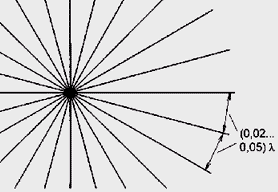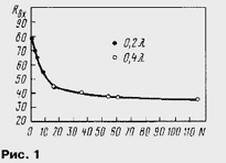Vertical antenna that requires a small area for installation, very popular among Amateurs. However, their effectiveness significantly depends on artificial ground - balances. General recommendation "than their more is better" is not always acceptable. It should be noted that in relation to the balances there are two fundamentally different situations. One of them occurs when there is an opportunity to raise the antenna high enough and the balances are removed from earth (the roof of the building, etc.). This is typical УSW the ranges. Here the number of balances, essentially, does not matter: one up to three or four. In the first case (with a single vertical counterweight) is obtained simple vertical dipole. In the second counterweights installed under some angle to the emitter, placing them evenly around the circumference to provide pie chart orientation. But both versions have in common is that the impact "earth" to work balances are insignificant.
The situation is different if the balances have to be placed very close to ground. This a common situation on the SW bands when the counterweights are from earth on a distance substantially smaller than the wavelength. Insufficient lead to a significant loss in poorly conducting ground (soil, building roofs, etc.) and therefore substantially reduce the efficiency of the antenna.
The analysis required in this case, the number of balances held at the time, W2FMI (Jerry Sevick. Short Ground Radial System for Short Verticals. - QST, 1978, April, p. 18). From the results of the analysis, two conclusions emerge. First, if this number balances there is a limit to their length, the excess of which no longer results in to increase the effectiveness of balances.
Secondly, when the length of the balances there is a limit to their number, the excess which also contributes to increased efficiency. The concept of "limit", which is the language used in these conclusions, rather blurred - coefficient action smoothly varies depending on the number of counterweights and their length.
Developing the above-mentioned provisions arising out of the W2FMI, G3SEK suggested (John White. In Practice. - RadCom. 1999, February, p. 45) a simple practical the criterion to determine the length and number of the balances that combines both o W2FMI in the same ratio. He estimated the length of the balances and the number should be such that the distance between the ends of the counterweights (see picture) was the TC, and the value of k may be in the range 0.02 to 0.05 probability level. If k is greater 0.05, and the losses will be significant. Decrease to 0.02 k improves efficiency the antennas. However, a further decrease in k already noticeable effect.

In the descriptions of many antennas are "resonant" counterweights length l/4, located at a small height above the roof. Based on the criterion G3SEK, to assert that such balances will become effective, if the number is not less than 30. All of the above correlation is valid for balances with the same length.
Ratio, referred to in this material, determine reasonable limits for a combination of "number of balances - length balances. Obviously, when the condition of these relations is the better of the two systems for a given antenna nevertheless will be the one that has greater length balances.
The publication ( "Radio", 1999, No. 6) aroused the interest of readers of the magazine, since the antenna GP is very popular among the Amateurs. Here is more information about the results obtained W2FMI (Jerry Sevick. Short Ground Radial System for Short Verticals. - QST, 1978, April, p. 30-33 ) in the study of the impact of the number of counterweights and their length on the efficiency of the antenna.
We are talking about SW antenna mounted close to the ground (almost without mast). In these experiments soil under the antenna on measurements W2FMI was "average", i.e. the had a conductivity of 15...30 MS/m ( large values refer to the soil after rain, less - dry). "Bad" for the antenna after the rain, the smaller - to dry). "Bad" for antennas considered soil, which has a conductivity of less than 5 MS/m (rocky, sand), and "very good" - about 100. Concrete roof modern buildings are, unfortunately, more likely to be "bad soil".
In Fig.1 shows the received W2FMI dependence of the input impedance of the antenna at the resonant frequency of the number of balances. It includes the resistance radiation (useful part) and resistance losses. The calculated value of the input the resistance used for W2FMI the diameter of the emitter and the ideal (without losses) "of the earth" was 35 Ohms.

As can be seen from Fig. 1, close to the value of the input resistance is achieved only when the number of balances over 50. In other words, with a smaller number of balances noticeable part of the transmitter power is not radiated by the antenna, and literally goes to the "ground". For the most commonly GP with three or four balances the input impedance will be about 70 Ohms and, accordingly, the efficiency of the antenna is about 50 %.
From the data shown in Fig. 1, it also follows that the length of balances not greatly affects the efficiency of the antenna.
This question W2FMI investigated in detail. The measurement results shown in Fig. 2, which shows the dependence of the efficiency of the antenna on the number of counterweights for the three options their length is l/4, l/8 and l/16. The analysis of these curves allows one to draw several conclusions.

First, the longer the balances, they are, generally speaking, more efficient.
Secondly, with a small number of counterweights their length has little effect on efficiency, so the efforts and money spent on the production of long balances can this case did not give significant results.
Thirdly, in certain conditions, short (less than l/4) balances can to ensure the same efficiency of the antenna, and how long.
The latter will explain in detail. From Fig. 2 shows that the same efficiency provide four counterweight length l/4, five to six balances of length l/8 and seven balances of length l/16. Moreover, twenty-length balances l/16 provide the same efficiency as eight counterweights length l/4. And constructive the advantages provided by the use of short balances (especially on low-frequency bands), is obvious.
Author: Jerry Sevick






